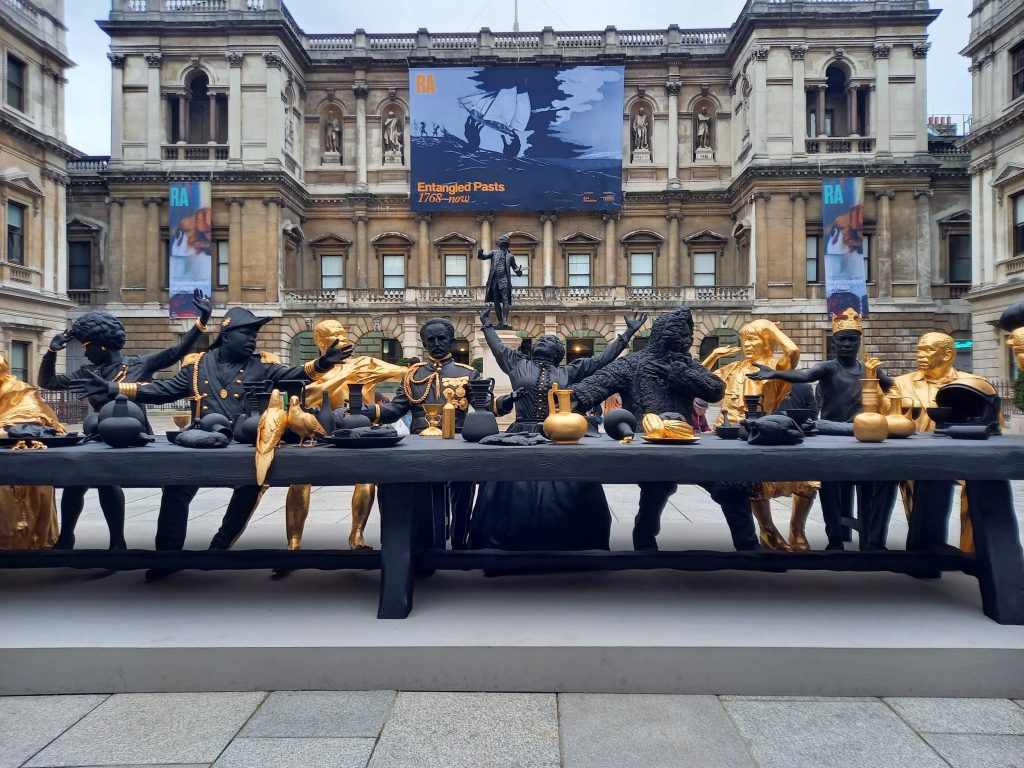LONDON – It’s one thing for a museum to commission a survey of its past colonial activity, as many UK institutions are doing after the Black Lives Matter movement and specifically the 2020 demolition of the Colston statue. Another is to encourage open dialogue to move forward as a society. This is the aim of the Royal Academy in the exhibition Entangled Pasts 1768–Present: Art, Colonialism and Change, which marries works from its 250-year history with contemporary responses from 50 RA-affiliated artists. His curation is at once academically rigorous, profound and emotionally moving.
Although framed by the history of RA, which gives the commentary on colonialism strength and a strong evidentiary base, it is organized ahistorically. This repeats the title’s reference to interconnectedness across time and geography. It suggests that the past is so “confused” that it rejects unique and definitive interpretations; instead, it is colored with countless shades. This is reflected in the exhibition’s pamphlet and not the wall texts, as is usual in London exhibitions, a collection of past and present poetry, and the texts of the campaign to abolish slavery from the 18th and 19th centuries. century

The approach could easily have resulted in an undisciplined scattering of ideas, yet the curators combine and organize visual examples with laser focus by dividing the display into clear themes and sub-themes. Furthermore, each room’s introductory footer follows a consistent format, starting with an aspect of the RA’s history, then contextualizing it in broader themes such as “Tradition and Appropriation” or “Conflict and Ambition,” and turning to contemporary considerations suggested by the curators. . Captions for individual works similarly do not impose a prescribed interpretation, but simply provide historical background, treating the viewer as intelligent and capable of exploring the wider potential implications of the art. This strategy crucially avoids layering the survey with hyperbolic emotions; The horrors of colonialism are evident throughout and speak for themselves.
Along with the interviews, the survey aims to document the colonialist connections between RA members and Black people who have been forgotten by history. As for the first, the captions detail these connections, a 1758 portrait of the daughters of Isaac Royall Jr., who himself owned a sugar plantation in Antigua and enslaved people in colonial Massachusetts, by John Singleton Copley, we’re told was unique. a well-known scholar of slave ownership.
For the latter, we have early records from the RA’s collections, such as the ‘box book’ of 1857–81, which details Jamaican-born Fanny Eaton’s work as a life model at the painting school. The most powerful is the series of portraits of the Black sitter. The caption contextualizes the Royal Academicians’ desire to establish Britain as a major artistic center amid the establishment of British rule in India and Britain’s Atlantic African slave trade. Many of these Senders stayed in Georgian Britain because of the extensive transportation networks that facilitated the plantation economy, and the RA continues to investigate their unrecorded identities.

In the center of the room is a classic bust of an unknown black man by Francis Harwood (1758). The caption explains how classicism perpetuated the Western canon, but allows the viewer to consider who the man was and what kind of life he led. Was it simply a means for the artist to present British classicist ideals, or did the artist believe he was elevating his subject? How did the audience of the time want to see the image: a large portrait of a real person or as a mere “exotic” room decoration? Such questions are raised throughout the show, allowing the audience to draw their own conclusions.
The academic rigor of the captions is offset by sharp responses from contemporary artists and some surprisingly inspired curators. In “Constructing Whiteness,” the white walls cleverly connect with the text conceptually, explaining how much the cotton economy in the British southern United States relied on slave labor. Nearby is LA-based artist Betye Saar’s “I’ll Bend but I will Not Break” (1998), an 18th-century British slave ship Brookes with an iron locked to an ironing board. Ku Klux Klan symbol.

Immediately following is a deep, cavernous blue room where the theme of the ocean is linked to the sublime of art through the idea of forced geographical displacement. Academic Frank Bowling’s “Middle Passage” (1970) is a dramatic cathartic transition, incorporating an abstract expressionist yellow and red firestorm that references the famous slave ship voyage, and Ellen Gallagher’s “Stablising Spheres” (2014). The Middle Passage depicts an underwater kingdom populated by pregnant women thrown into the sea, who gave birth to babies who could breathe underwater.
The need to explore the traces of colonial history and its influence that continue to hold British society is evident in the final room, “Where to from here?” With the Colston statue in mind, recent graduate Olu Ogunnaike RA takes Trafalgar Square’s Fourth Plinth, an enduring symbol of public art and the state as a platform for political expression, and recreates it in faux wood, referencing luxury furniture exported around the world. wooden ships that transported slaves. The importance of this show in confronting colonialism cannot be overstated, as well as the role of art in documenting and encouraging the public to actively explore these issues and their place in society. It sets an example of how not only to look to the past to evaluate it, but, crucially, how it can encourage collective self-reflection and change for the future.


Entangled Pasts 1768–Present: Art, Colonialism and Change Continues at the Royal Academy of Arts (Burlington House, Piccadilly, London, England) until 28 April. The exhibition has been curated by Dorothy Price, Cora Gilroy-Ware and Esther Chadwick.


